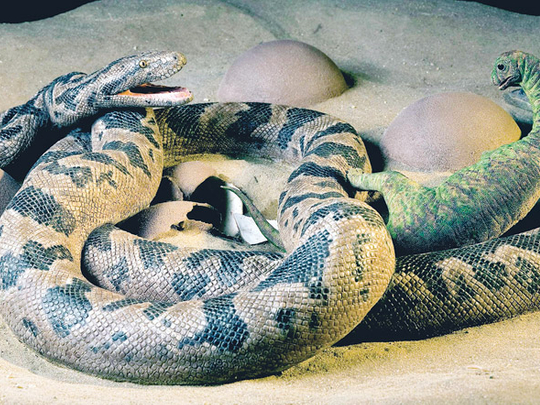
Bangkok: The fossilised remains of a snake that lived 67 million years ago and was found coiled around a dinosaur egg offers rare incite into the ancient reptile's dining habits and provides some important clues to its evolution, scientists said Tuesday.
The findings, which appeared in this Tuesday's issue of the peer-reviewed journal of PLoS Biology, for the first time offer evidence that an ancient, 3.5-metre- (11.48-foot-) long snake fed on the eggs and hatchlings of saurapods - making these reptiles one of its few predators of this giant mammal.
It also offers evidence that snakes as early as 100 million years ago during the Upper Cretaceous period were developing mobile jaws that had some similarities to large-mouthed snakes like vipers and boas that roam the earth today.
"This is an early, well preserved snake and it is doing something. We are capturing it's behavior," said University of Michigan paleontologist Jeff Wilson, who is credited with discovering the snake bones amid the crushed dinosaur eggs and bones of hatchlings.
"We have information about what this early snake did for living," he said. "It also helps us understand the early evolution of snakes both anatomical and ecologically."
Dhananjay Mohabey of India's Geological Survey discovered the fossilised remains in 1987 but he was only able to recognise the dinosaur eggshells and limb bones. Wilson examined the fossils in 2001 and was "astonished" to find a predator in the midst of the sauropod's nest.
"I saw the characteristic vertebral locking mechanism of snakes alongside dinosaur eggshell and larger bones and I knew it was an extraordinary specimen," Wilson said.
Mohabey theorised that the snake dubbed Sanajeh indicus, which means "ancient-gaped one" in Sanskrit, had just arrived at the nest and was in the process of gobbling a hatchling as it emerged from its egg. But the entire nest was "frozen in time" when it was hit by a storm or some other disaster and buried under layers of sediment.
"We think the hatchlings had just exited its egg and the activity attracted the snake," Mohabey said, adding that the site in Western state of Gujarat has revealed about 30 sauropod nests and at least two other snake specimens.
Michael Benton of the University of Bristol, also writing in the PLoS Biology, said it can be difficult to determine the behavior of ancient organisms. But he said that it was "most likely, as the authors argue, that this snake was waiting and snatching juveniles as they hatched."
"Of course, we cannot be entirely sure unless further specimens come to light showing the bones of juvenile dinosaurs in the stomach region of the snake," Benton said.
Ashok Sahni, a senior scientist at the Indian National Science Academy who was also not involved in the dig, described the find as "truly remarkable" because it is rare for fossil bones to be preserved at the site of fossilized eggs.
"The scientific significance of the find is that it actually demonstrates behavior in early evolved snakes and the size of chosen prey," he said in an e-mail interview.












